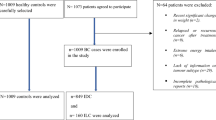Abstract
Various aspects of adult diet have been linked to breast cancer development. These include intake of fat (risk factor), and intake of fibre, soy protein and vitamins A, C and E (protective factors). Results of previous studies have been inconsistent. We examined the possible associations between breast cancer and various indices of nutrient and food intake in two Chinese populations who are at relatively low risk for breast cancer (one-fifth the rate in US white women). Two case-control studies of breast cancer were conducted in the cities of Shanghai and Tianjin, China. In Shanghai, 534 women aged 20-69 years with histologically confirmed breast cancer were recruited, whereas in Tianjin 300 women aged 20-55 years with histologically confirmed breast cancer were interviewed. All controls were community controls who were individually matched to the cases by sex and age (case-control ratio = 1:1). All interviews were conducted in person. Findings from the two studies were similar, although the diets in Shanghai and Tianjin were different in many respects. Cases and controls were similar in their consumption of soy protein, measured either in absolute levels or as percentages of total protein. Overall, all components of dietary fat (saturated fat, monounsaturated fat, polyunsaturated fat) showed a modest, non-significant association with breast cancer after adjustment for energy intake and other non-dietary risk factors for breast cancer. Intake of crude fibre, carotene and vitamin C, on the other hand, exhibited strong, statistically significant inverse associations with breast cancer risk. The last three indices were highly correlated, rendering it impossible to disentangle their individual effects; they were closely associated with intake of green vegetables in the two study populations. Vitamin E intake was unrelated to breast cancer risk in Shanghai and Tianjin. In the multivariate logistic regression model which included all non-dietary risk factors for breast cancer and energy intake, Shanghai women in the lowest tertile of crude fibre intake and highest tertile of fat intake had a 2.9-fold increased risk for breast cancer relative to those in the highest tertile of crude fibre intake and lowest tertile of fat intake. The comparable relative risk in Tianjin women was 2.4. Our data indicate a strong protective effect against breast cancer development with intake of foods rich in fibre, vitamin C and carotene. Our results are also compatible with dietary fat having a modest, positive effect on breast cancer risk within the range of exposure experienced by women in China.(ABSTRACT TRUNCATED AT 250 WORDS)
This is a preview of subscription content, access via your institution
Access options
Subscribe to this journal
Receive 24 print issues and online access
$259.00 per year
only $10.79 per issue
Buy this article
- Purchase on SpringerLink
- Instant access to full article PDF
Prices may be subject to local taxes which are calculated during checkout
Similar content being viewed by others
Author information
Authors and Affiliations
Rights and permissions
About this article
Cite this article
Yuan, JM., Wang, QS., Ross, R. et al. Diet and breast cancer in Shanghai and Tianjin, China. Br J Cancer 71, 1353–1358 (1995). https://doi.org/10.1038/bjc.1995.263
Issue Date:
DOI: https://doi.org/10.1038/bjc.1995.263


